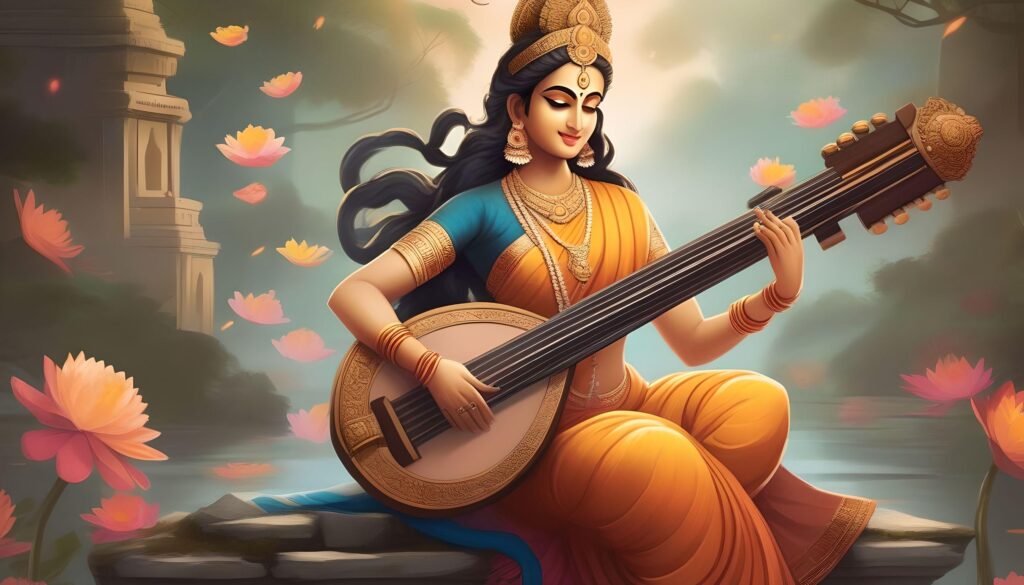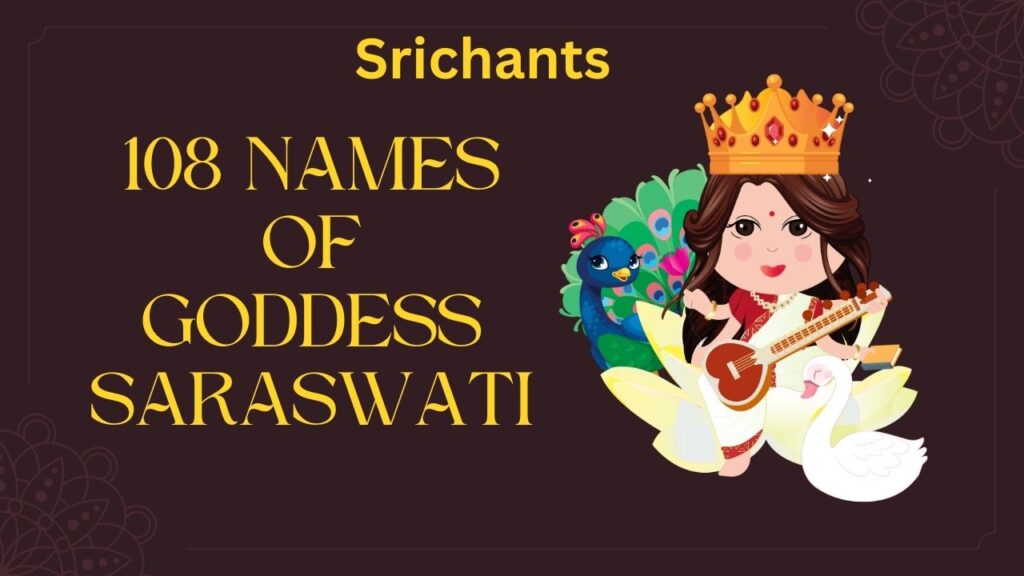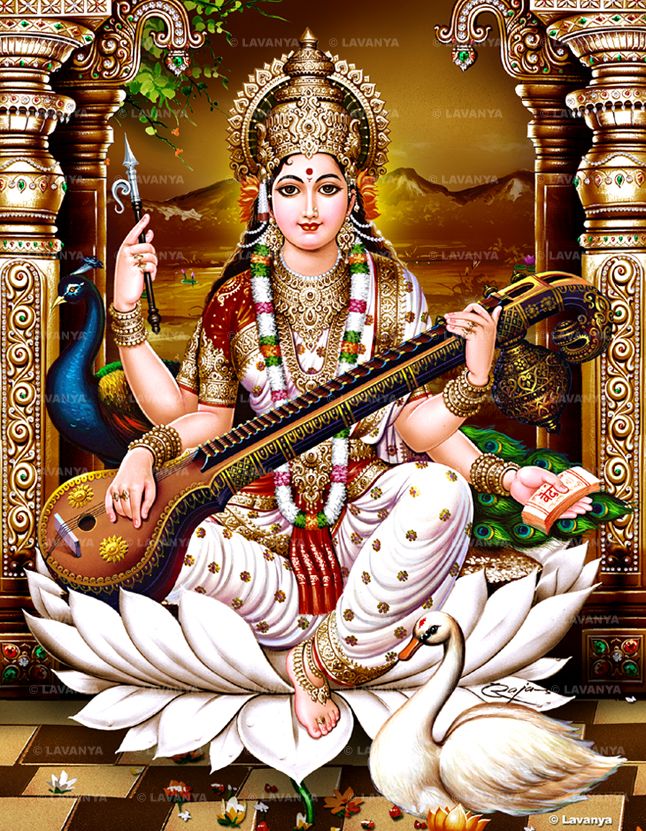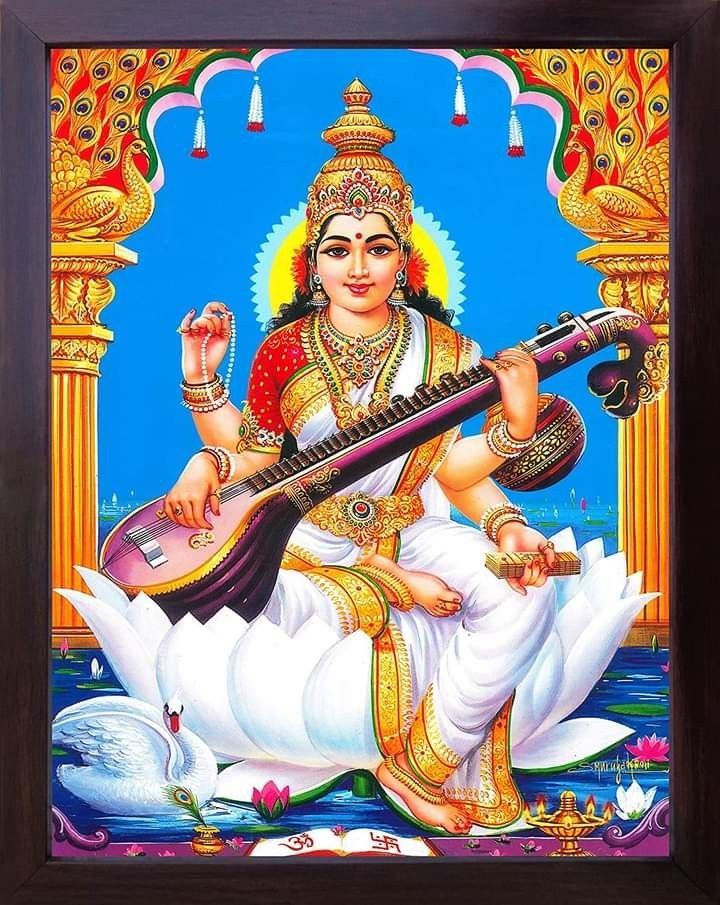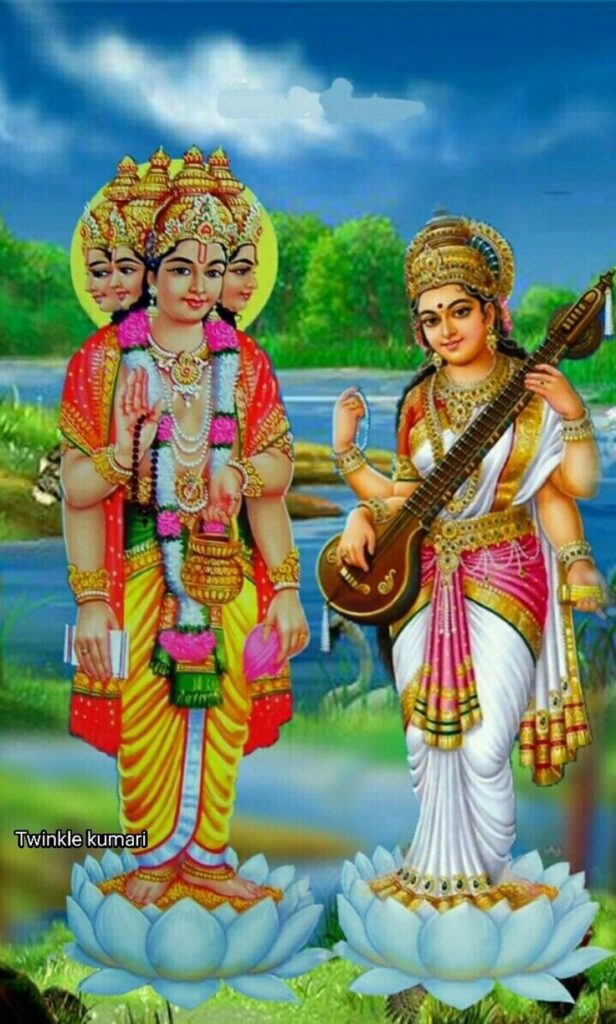God of Saraswati : Influence in Modern Hindu Practices
Introductions
Among the many threads of Hindu mythology, Goddess Saraswati is a lighthouse of knowledge, wisdom, and creative expression. Originally mostly regarded as the personification of the holy Saraswati River, this multifarious god has developed throughout time to represent language, education, and the creative arts. Her ongoing importance in the Hindu pantheon is evidence of the great influence she has had on the intellectual and cultural terrain of the Indian subcontinent; her influence is still felt in the present.
The symbolic importance of Saraswati
Saraswati’s ongoing attraction stems from the complex symbolism connected with her heavenly persona. She is considered as the manifestation of the creative power underlying the fundamental fabric of the universe as the consort of the Creator god Brahma. Her features—the white lotus upon which she is frequently shown, the swan she rides, the holy books and musical instrument she carries—all have great spiritual and metaphysical connotations.
The White Lotus’s Symbolic Meaning
With roots grounded in the mud but magnificent petals rising into the light, the white lotus symbolizes the capacity to transcend the physical world and reach a condition of spiritual illumination. Sitting on this pure and brilliant flower, Saraswati is said to be anchored in the Supreme Reality, therefore representing her function as the goddess of actual knowledge and wisdom.
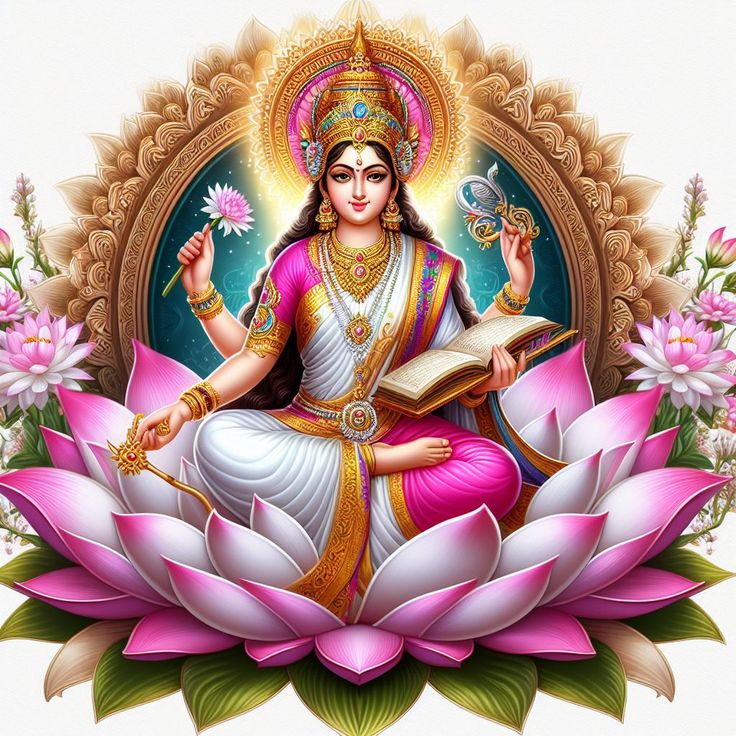
Swan as a Discernment Symbol
Hindu philosophy finds great significance in the swan, Saraswati’s chosen means of mobility. It is thought to have the special power to separate milk from water, a metaphor for the capability to tell the real from the false, the important from the surface. Saraswati is supposed to represent the force of wisdom by selecting the swan as her chariot, therefore motivating her followers to develop the same clarity of mind in their search of knowledge and understanding.
The Vedas and the Veena
Often shown with Saraswati, the musical instrument known as the Veena symbolizes the harmony and rhythm supporting the universe. Its prominence in her iconography points to her patronage of the arts, especially poetry and music, which are considered as means of the divine expression. Likewise, the revered books of the Vedas—which she holds in one of her hands—symbolize the whole body of human knowledge and the path toward spiritual illumination.
Evolution of Saraswati from River Goddess to Goddess of Learning
The change of Saraswati’s image from a river goddess to the goddess of learning and the arts is evidence of Hindu mythology’s vitality and flexibility. Early Vedic times saw Saraswati mostly connected with the venerated sacred river bearing her name, known for its life-giving and cleansing qualities. But as Hindu theology came to value language and speech, Saraswati’s influence grew to include Vak, the goddess of communication and expression.
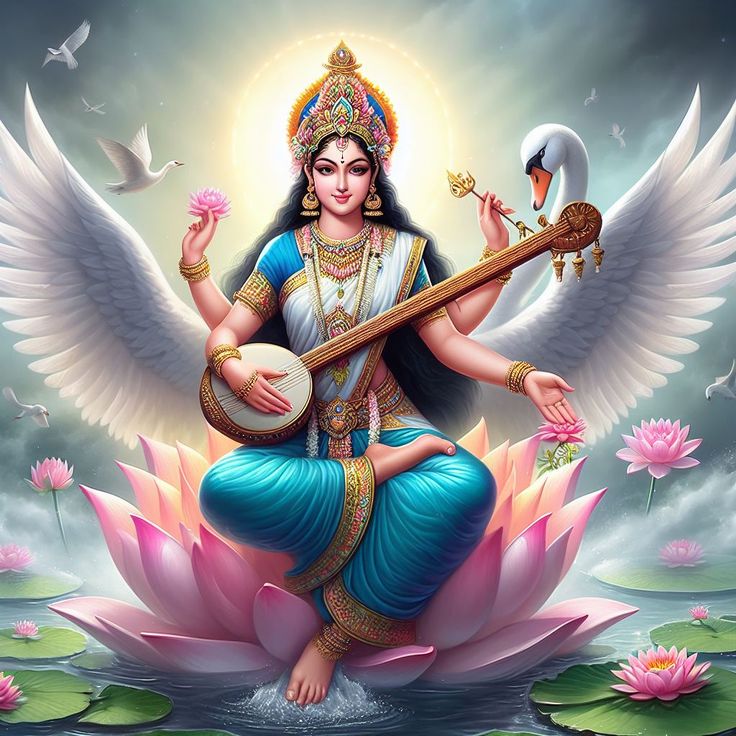
The Move to Vak and the Value of Language
With the heavenly mantra “Om” understood as the actual sound of creation, the Vedas, the fundamental books of Hinduism, stress the creative power of speech. Saraswati came to be seen as the source of all language and the inspiration behind artistic and lyrical expression as the embodied Vak. Her reputation as the patron of learning, scholarship, and the intellectual interests was strengthened by her link with the spoken and written word.
The Consort of Brahma’s Emergence as Saraswati
Saraswati’s changing character also shows in her interaction with the Hindu trinity. Originally considered as an autonomous river goddess, she later grew to be intimately linked with Brahma, the creator deity. With Saraswati’s creative energies acting as the necessary complement to Brahma’s generative capacity, this marriage represents the inherent link between the act of creation and the power of language.
Hindu Practices’ Veneration of Saraswati
From the celebration of yearly events to the daily rituals and practices of followers, the respect for Goddess Saraswati penetrates many facets of Hindu religious and cultural life.
The Significance of Vasant Panchami
Celebrated on the fifth day of the brilliant fortnight of the Hindu month Magha, Vasant Panchami commemorates the beginning of spring and is among the most well-known festivities of Saraswati. Devotees assemble on this fortunate day to honor the goddess, outfit her picture in white clothing, and give prayers and devotional music. The white hue, which stands for knowledge and purity, permeates the celebrations and youngsters are often started into the world of learning by receiving their first lessons in reading and writing.
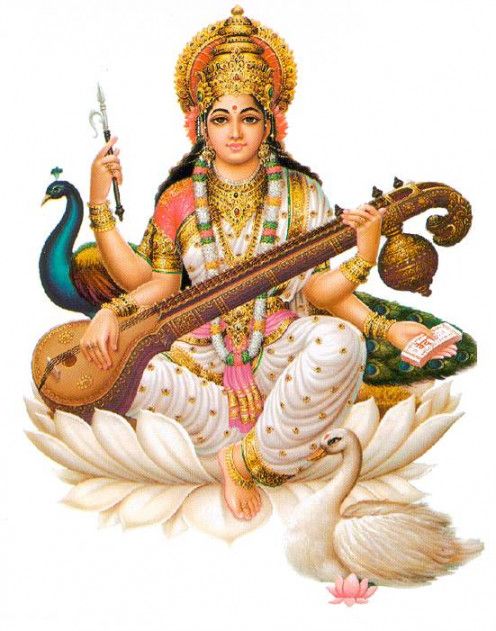
Saraswati Puja in Learning environments
Saraswati is revered in the field of education as well as the line of religious observances. From colleges to elementary schools, many Indian academic institutions celebrate Saraswati Puja, in which the goddess is invoked to bless staff members and students with gifts of knowledge, wisdom, and intellectual ability. These rituals not only honor the deity but also strengthen Saraswati’s close relationship with the quest of knowledge.
Saraswati’s Involvement in Everyday Events
For Hindu followers, Saraswati’s influence shows itself in a variety of ceremonies and activities in daily life. Whether it’s the beginning of a new academic year, the opening of a business venture, or the start of a creative undertaking, people often seek the goddess’s blessings by doing Saraswati Puja before starting any significant activity. This act of invocation is thought to provide the endeavor the divine energy and inspiration required for its effective execution.
Saraswati’s continuing relevance in the modern era
The figure of Goddess Saraswati has stayed steady and lasting as the Hindu faith has developed and changed to fit the times; her impact is felt in many spheres of modern Indian society.
Saraswati and the search for wisdom
Saraswati’s patronage of the arts and education still holds great respect in the current classroom. Seeking her heavenly direction and inspiration, students, academics, and researchers routinely call her blessings before significant tests, research projects, or academic presentations. Saraswati’s iconography found in educational institutions reminds us constantly of the value of knowledge, wisdom, and intellectual interests in the Hindu perspective.
Saraswati and the Creative Arts
The goddess’s connection with the creative arts—especially poetry and music—has also persisted in the modern period. Believing that Saraswati’s heavenly spirit will fill their work with more depth, beauty, and emotional resonance, artists, musicians, and performers still seek her blessings before beginning their creative activities. varied regions of India’s yearly Saraswati Puja festivities include energetic cultural events highlighting the varied artistic skills of the local population, therefore underlining the goddess’s ongoing impact on the creative scene.
Saraswati from the Digital Age
The impact of Goddess Saraswati has also reached the digital sphere in this day of fast developing technology. Seeking heavenly direction and inspiration for their creative endeavors, many software businesses and technology startups in India include Saraswati’s iconography or call for her blessings. The goddess’s ageless and flexible influence is highlighted by this mixing of modern technology developments with old Hindu customs.
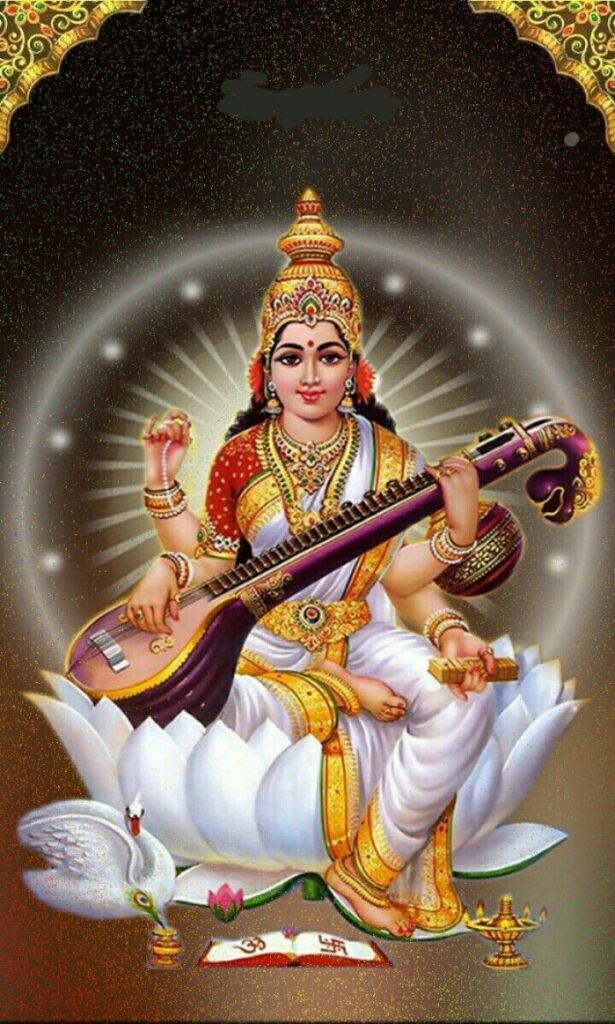
Globally reach and cross-cultural influences of Saraswati
Respect of Goddess Saraswati transcends the Indian subcontinent by itself. Her impact has cut beyond national boundaries and found resonance in many civilizations and religious systems all around.
Saraswati: Chinese and Japanese Mythologies
Saraswati is regarded as the goddess of riches, knowledge, and the arts in Japan and China; her name is Benzaiten or Benten there. Particularly the Japanese Shinto custom has welcomed the goddess, including her into their pantheon of gods and honoring her via many celebrations and ceremonies.
Saraswati according to Buddhist traditions
Buddhist traditions have also embraced Saraswati, also known as a bodhisattva, or enlightened being, connected with wisdom, education, and the creative arts. For practitioners aiming to develop knowledge and compassion in Tibetan Buddhism, Saraswati is revered as Tara, the feminine incarnation of enlightened activity and the object of dedication.
The Universal Message of Saraswati
The great respect of Goddess Saraswati in many religious and cultural settings emphasizes the universality of her message and the ageless relevance of the principles she stands for. Whether it is the search of knowledge, the expression of creativity, or the attainment of spiritual enlightenment, the image of Saraswati acts as a uniting symbol that cuts over territory, language, and religious systems.
Conclusion
A monument to the ongoing strength of the divine feminine in the Indian spiritual terrain, Goddess Saraswati’s continuing impact in modern Hindu rituals is evidence She is still a symbol of the close relationship between the material and the spiritual spheres as the embodiment of knowledge, wisdom, and artistic expression; she inspires and guides followers in their search for intellectual and creative satisfaction.
The figure of Saraswati stays a constant and comforting presence as Hinduism develops and adjusts to the reality of the modern world, reminding us of the timeless value of education, the transforming power of the arts, and the need of developing a discriminating mind in our search of truth and illumination. The respect and loyalty paid to this multifarious goddess is evidence of her continuing impact and the wisdom she stands for’s ongoing applicability.
#maa #saraswati #maasaraswati #godofsaraswati #godsaraswati
